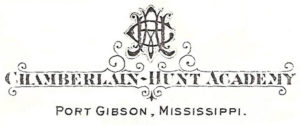 Although the Walnut Street campus wasn’t operating at full capacity at the end of the nineteenth century, the Board of Trustees stepped out on faith, taking steps to construct a new campus to attract more students and broaden the programs the Academy could offer. Elder James Grafton Spencer, who had served in the US House of Representatives from 1895-1897, was elected President of the Board, and he was able to use his nationwide connections to help raise the needed funds.
Although the Walnut Street campus wasn’t operating at full capacity at the end of the nineteenth century, the Board of Trustees stepped out on faith, taking steps to construct a new campus to attract more students and broaden the programs the Academy could offer. Elder James Grafton Spencer, who had served in the US House of Representatives from 1895-1897, was elected President of the Board, and he was able to use his nationwide connections to help raise the needed funds.  The key donation came from James Jennings McComb, at one time a resident of Port Gibson. He had made a fortune inventing a machine that more efficiently bound cotton bales, and was willing to give $50,000 toward the project. He also hand-picked George Palliser as architect to design the campus.
The key donation came from James Jennings McComb, at one time a resident of Port Gibson. He had made a fortune inventing a machine that more efficiently bound cotton bales, and was willing to give $50,000 toward the project. He also hand-picked George Palliser as architect to design the campus.
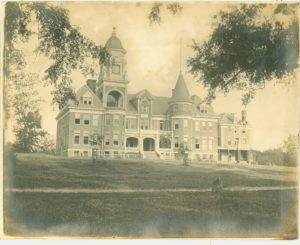 The buildings that became known as McComb and Guthrie were finished in less than one year. Mr. S.W. Rothrock signed a contract to build them on May 5, 1900, and the Trustees received the completed buildings in April of 1901.
The buildings that became known as McComb and Guthrie were finished in less than one year. Mr. S.W. Rothrock signed a contract to build them on May 5, 1900, and the Trustees received the completed buildings in April of 1901.
At the time, McComb Hall was twice  as tall as it is today, a full four stories high, and topped with two spires. Although Palliser’s plans called for another dormitory, a mirror image of Guthrie Hall, to be placed where Redus Hall now stands, funds were insufficient for another such structure to be built. Instead, the campus was completed with the construction of the President’s Home, finished in November of 1902.
as tall as it is today, a full four stories high, and topped with two spires. Although Palliser’s plans called for another dormitory, a mirror image of Guthrie Hall, to be placed where Redus Hall now stands, funds were insufficient for another such structure to be built. Instead, the campus was completed with the construction of the President’s Home, finished in November of 1902.
An increase in the size and capacity of the school necessitated a transfer in ownership from the Presbytery of Mississippi, which covered only the Southwest corner of the state, to the Synod of Mississippi, which included a much broader area. It seems that the plan was even more ambitious – for Chamberlain-Hunt to grow into a men’s college that would complement Belhaven, the Synod’s college for women. But before this grand plan could be put into effect, the advent of the boll weevil destroyed Mississippi’s prosperity. Appearing in Claiborne County in 1909, it sparked an exodus from the area. The county’s population fell from just over 20,000 in the year 1900 to just over 13,000 in 1920.
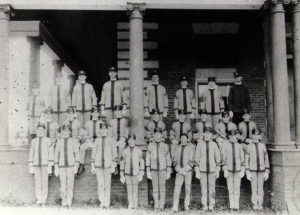 The 1905-06 school year seems to have been the first time that participation in the military program became required for all students. The catalog of that year stressed the many benefits of military discipline:
The 1905-06 school year seems to have been the first time that participation in the military program became required for all students. The catalog of that year stressed the many benefits of military discipline:
“The prime essentials of moral development are respect for authority, habits of obedience, order, punctuality, system, self-control, and a feeling of individual responsibility. Experience has established the fact that these can best be secured in school life under a military system. Besides, it secures neatness of person, precision of action, erect and graceful carriage, and gentlemanly manners, together with physical health and strength, a more satisfactory progress in s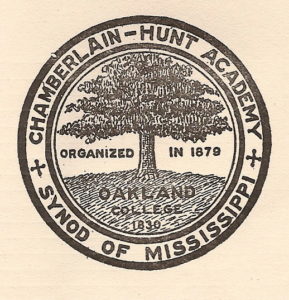 tudies, and complete supervision.”
tudies, and complete supervision.”
Of course, not everyone agreed. After W.C. Guthrie’s retirement in June of 1907, Rev. Marion E. Melvin moved from the Presbyterian Church in Port Gibson to become the Academy’s Principal. Under his leadership, the military program was suspended in the Fall of 1910, only to be reintroduced in the Spring of 1916. In September of 1917, CHA once again opened up as a full military school, a status it would retain until the Fall of 2013.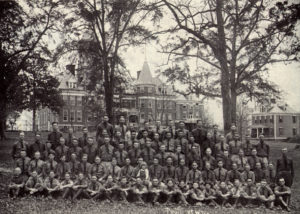
http://cha.fpcportgibson.com/wp-content/uploads/2022/04/1912-Annual-CHAts-Complete.pdf